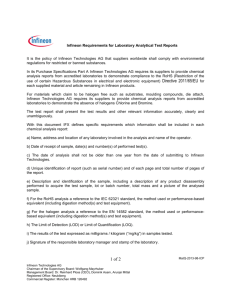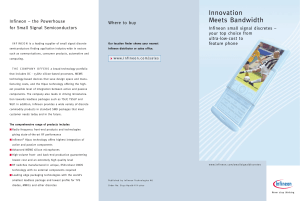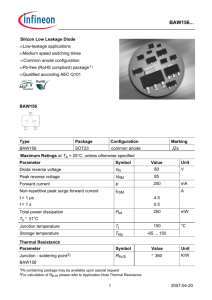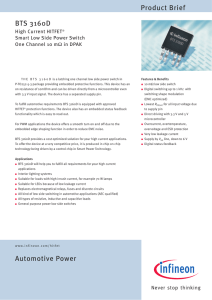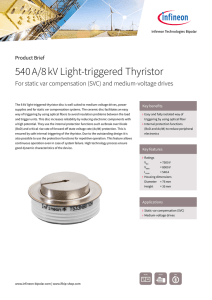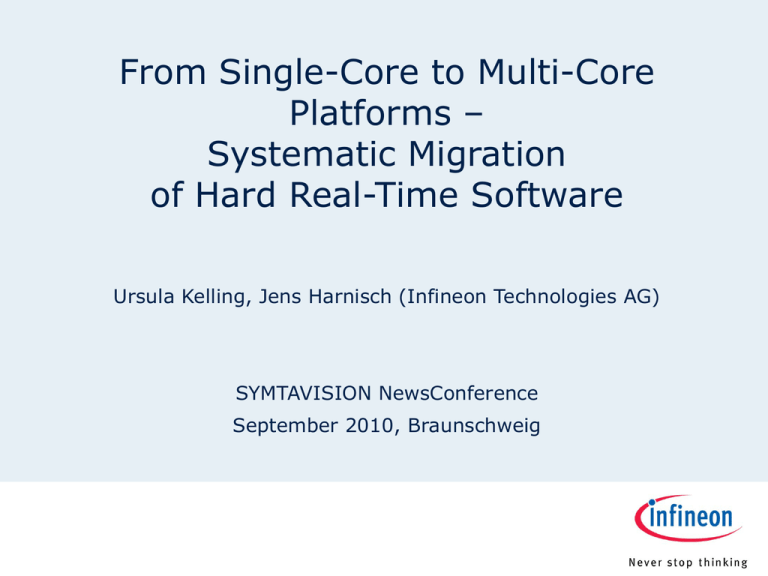
From Single-Core to Multi-Core
Platforms –
Systematic Migration
of Hard Real-Time Software
Ursula Kelling, Jens Harnisch (Infineon Technologies AG)
SYMTAVISION NewsConference
September 2010, Braunschweig
Outline
Drivers and use cases for automotive multi-core
architectures
Science to real world: Today
Future controller architectures
Practical challenges when moving to multi-core
Development flow for multi-core software development
Multi-core scheduling analysis with SymT/AS
Summary and outlook
24-Sep-10
Copyright © Infineon Technologies 2010. All rights reserved.
Page 2
Drivers and use cases for automotive multicore architectures
Drivers:
High-Integration: Functionality of two or
more ECUs is combined on one ECU and
hence on one microcontroller
Higher performance requirements: New
control algorithms require more
computational power; however, this can
only be realized with multi-core
approaches, and not with higher clock
rate (e.g. due to EMC and thermal
problems): clearly challenging for
software development
Use cases:
Power-train (Gas/Diesel Direct Injection,
Hybrid Control, E-Motor Drive)
Body, chassis, safety
Note: Scientific notations are according to „Scheduling in Computer and Manufacturing
Systems“ published by Błazewicz et al.
24-Sep-10
Copyright © Infineon Technologies 2010. All rights reserved.
Page 3
Science to real world: Today
Real World
Science
R2 | es, prec, rj, (dj), cj | Cmax
Two processors, having a different
feature set. (unrelated processors)
Preemptions are allowed
Resources have to be managed, to
avoid deadlocks.
Dependencies between tasks.
Release times.
Deadlines might be existent
Communication times
Optimization criterion is the
maximum processing time, or it
could be Lmax the lateness of tasks
In any case, the problem is NP
hard, so more than one solution
sub-optimal solution exists.
24-Sep-10
Copyright © Infineon Technologies 2010. All rights reserved.
Page 4
Science to real world: Today
Real World
Science
R2 | pmtn, res, prec, rj, (dj), cj
Two processors, having a different
feature set. (unrelated processors)
Preemptions are allowed
Resources have to be managed, to
avoid deadlocks.
Dependencies between tasks.
Release times.
Deadlines might be existent
Communication times
Optimization criterion is the
maximum processing time, or it
could be Lmax the lateness of tasks
In any case, the problem is NP
hard, so more than one solution
sub-optimal solution exists.
24-Sep-10
Copyright © Infineon Technologies 2010. All rights reserved.
Page 5
Science to real world: Today
Real World
Science
R2 | pmtn, res, prec, rj, (dj), cj | Cmax
Two processors, having a different
feature set. (unrelated processors)
Preemptions are allowed
Resources have to be managed, to
avoid deadlocks
Dependencies between tasks.
Release times.
Deadlines might be existent
Communication times
Optimization criterion is the
maximum processing time, or it
could be Lmax the lateness of tasks
In any case, the problem is NP
hard, so more than one solution
sub-optimal solution
24-Sep-10
Copyright © Infineon Technologies 2010. All rights reserved.
Page 6
Science to real world: Today
Real World
Science
R2 | pmtn, res, prec, rj, (dj), cj | Cmax
Two processors, having a different
feature set. (unrelated processors)
Preemptions are allowed
Resources have to be managed, to
avoid deadlocks
Dependencies between tasks
Release times
Deadlines may exist
Communication times
Optimization criterion is the
maximum processing time, or it
could be Lmax the lateness of tasks
In any case, the problem is NP
hard, so more than one solution
sub-optimal solution exists.
24-Sep-10
Copyright © Infineon Technologies 2010. All rights reserved.
Page 7
Science to real world: Today
Real World
Science
R2 | pmtn, res, prec, rj, (dj), cj | Cmax
Two processors, having a different
feature set. (unrelated processors)
Preemptions are allowed
Resources have to be managed, to
avoid deadlocks
Dependencies between tasks
Release times
Deadlines may exist
Communication times
Optimization criterion is the
maximum processing time, or it
could be Lmax the lateness of tasks
In any case, the problem is NP
hard, so more than one sub-optimal
solution exists
Communication
24-Sep-10
Copyright © Infineon Technologies 2010. All rights reserved.
Page 8
Runtime of a task
Dependent on the location of a task, the runtime might change.
Due to the fact, that RAM has less wait states than (un-cached)
Flash, and Flash has less wait states than external memory,
every task has memory dependent runtimes.
Already today, accessing the local RAM of the CPU is faster than
accessing the RAM of another CPU (communication time or wait
states have to be added)
24-Sep-10
Copyright © Infineon Technologies 2010. All rights reserved.
Page 9
Growing complexity
Qm | pmtn, res, prec, rj, (dj), cj | Cmax (or Lmax)
Which means, that uniform processors will be put into the
system (same capabilities, but different speeds)
Additional local and “external” memories will exist.
As m = 1, .., n a help for scheduling tasks is necessary.
Gantt charts are a tool to show schedules:
Up to 6 tasks of course you could use these:
24-Sep-10
Copyright © Infineon Technologies 2010. All rights reserved.
Page 10
How to connect many cores on an
automotive microcontroller?
Attach all cores to a bus? Bandwidth limitation!
Attach all cores to a cross bar? Does not scale to many cores!
Use a network on chip? Missing real time capability!
Use different domains (e.g. computation domain, communication domain) and cross bars
within domains? May work!
Further
PMU
TriCore
PMI
DMI
cores….
´Shared Resource Interconnect
(Computation Domain)
Further
Bridge
PMI
TriCore
DMI
cores….
COM
peripheral
Timing
peripheral
Conversion
peripheral
Further
peripherals
…
System Peripheral Bus
(Peripheral Domain)
Scheduling analysis on chip will become more complicated, with possibly different
execution times on cores and communication overhead.
24-Sep-10
Copyright © Infineon Technologies 2010. All rights reserved.
Page 11
Practical challenges when
moving to multi-core
New hardware requires new compiler and new OS version
Architectures are not always directly comparable to predecessors due to
different clock rates, connectivity and memory characteristics
Software mapping to cores uses new communication primitives
Many changes at once! The practice:
Why is the performance not as expected?
Solution for investigation:
Use a model based approach
Use communication cost catalogue
24-Sep-10
Copyright © Infineon Technologies 2010. All rights reserved.
Page 12
Development flow for multi-core
software development
Hardware metamodel with ECU,
core, memory types
Generic
communication
benchmark
Automatic
import
Timing
information
about
computational
load
24-Sep-10
Software meta model
with runnables and
tasks
Model of the
application
with mapping
of runnables,
tasks and
variables
Verification
Application
metric,
supported
with
dedicated
charts in
SymT/AS
Copyright © Infineon Technologies 2010. All rights reserved.
Application
with
mapping of
runnables,
tasks and
variables
Hardware or
virtual prototype
Page 13
Multi-core scheduling analysis with
SymT/AS
Remote load /
(Remote + Local)
Green: Variable
mapped on this core
Load on cores,
caused by
variable access
Variables
24-Sep-10
Copyright © Infineon Technologies 2010. All rights reserved.
Globally mapped
variable
Page 14
Summary and outlook
Moving to multi-core systems does not always make a transition in small
steps possible, model based approaches and tool support gain
importance
The project developed a flow with consideration of communication and
computational costs, to conduct system analysis on a model level, and
investigate/analyze more efficiently than on the real target only
Flow could be used in the future to automatically generate advice for
better application mapping
Please check the demonstrator!
24-Sep-10
Copyright © Infineon Technologies 2010. All rights reserved.
Page 15
Acknowledgements
Christoph Ficek, Ingo Houben and Dr. Kai Richter
(SYMTA VISION GmbH)
Peter Gliwa and Nick Merriam (Gliwa GmbH)
Gerd Punsmann, Harry Siebert and Arndt Voigtländer
(Infineon Technologies AG)
24-Sep-10
Copyright © Infineon Technologies 2010. All rights reserved.
Page 16
Acknowledgements
Thank you for your attention!
Christoph Ficek, Ingo Houben and Dr. Kai Richter
(SYMTA VISION GmbH)
Peter Gliwa and Nick Merriam (Gliwa GmbH)
Gerd Punsmann, Harry Siebert and Arndt Voigtländer
(Infineon Technologies AG)
24-Sep-10
Copyright © Infineon Technologies 2010. All rights reserved.
Page 17

